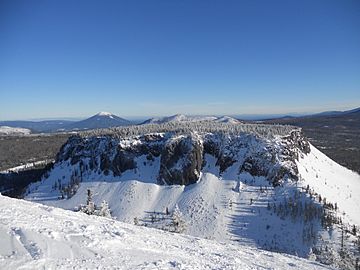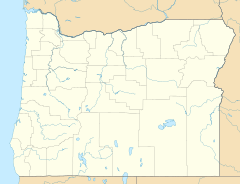Hayrick Butte facts for kids
Quick facts for kids Hayrick Butte |
|
|---|---|

Hayrick Butte seen from the top of Hoodoo Ski Area
|
|
| Highest point | |
| Elevation | 5,482 ft (1,671 m) |
| Geography | |
| Location | Linn County, Oregon, U.S. |
| Parent range | Cascades |
| Topo map | United States Geological Survey Three Fingered Jack |
| Geology | |
| Mountain type | Tuya |
Hayrick Butte is a special type of volcano called a tuya. A tuya forms when lava erupts under a thick layer of ice or a glacier. This makes it a "subglacial volcano." Hayrick Butte is located in Linn County, Oregon.
You can find Hayrick Butte in the Willamette National Forest, close to Santiam Pass. It's right next to Hoodoo Butte, which is a different type of volcano called a cinder cone and has a popular ski area. Hayrick Butte has a flat top, like a table, and its sides are very steep. It rises about 700 feet (0.21 km) above the land around it.
Even though it's not as popular as Hoodoo Butte, people can still climb Hayrick Butte. There are also trails for hiking, snowshoeing, and snowmobile riding nearby. The north side of the butte has cool, wet forests with mountain hemlock and fir trees. These trees are common in the Cascades.
Contents
Where is Hayrick Butte?
Hayrick Butte is found in Linn County, Oregon. It's part of the United States Geological Survey map for the Three Fingered Jack volcano area. Hayrick Butte is south of Three Fingered Jack and close to Hoodoo Butte. Other nearby landforms include Sand Mountain Field, Potato Butte, and Black Butte. Further south, you'll find Belknap Crater and Mount Washington.
Hayrick Butte is also inside the McKenzie Ranger District of the Willamette National Forest. Its height is about 5,482 feet (1,671 m). The butte is about 0.5 miles (0.80 km) wide across its flat top.
Hayrick Butte is right next to the Hoodoo ski area. In the past, there were plans to develop the area around Hoodoo and Hayrick Buttes. This would have involved digging up a lot of soil and rock from Hayrick Butte. Experts worried this could cause more erosion and make it harder for plants to grow back. However, they also thought that new trails wouldn't spoil the beautiful views too much.
Animals and Plants at Hayrick Butte
In the early 1990s, wildlife experts thought that peregrine falcons might build nests at Hayrick Butte. However, they decided it wasn't the best place for them. This was because there weren't many good ledges for nests, and too many people visited the area.
A study from 2003 showed that Hayrick Butte has a rich forest on its steep, north-facing side. This forest has mountain hemlock and mature fir trees. These types of forests, called subalpine forests, usually grow above 4,900 feet (1,500 m) in the Cascades. They thrive in cool, wet places with lots of snow in winter. At very high elevations, the forests become less dense, with patches of trees separated by shrubs or open meadows.
How Hayrick Butte Formed
Hayrick Butte is a tuya, which means it's a volcano that erupted under a thick layer of ice. It formed during the late Pleistocene Ice Age. When the hot lava met the cold ice, it cooled quickly. This process created the flat top and steep, almost vertical sides that Hayrick Butte has today.
Both Hayrick Butte and a nearby tuya called Hogg Rock were shaped by glaciers. Glaciers are like giant rivers of ice that slowly move and carve out the land. These volcanoes are made of a type of lava called andesite. This lava often contains small crystals of minerals like plagioclase and orthopyroxene.
Hayrick Butte also played a role in protecting Hoodoo Butte during the Ice Age. It acted like a shield, stopping the moving glaciers from eroding the top of Hoodoo Butte.
Most volcanoes in the Cascades are found in groups or near larger volcanoes. For example, there are many lava domes near Mount Jefferson and Mount Mazama. However, Hayrick Butte is more isolated. It formed far away from any major stratovolcanoes, which are the large, cone-shaped volcanoes like Mount Hood.
The Story Behind the Name
A cartographer (a mapmaker) named Stuart Allen believes there was a mistake long ago. He thinks the names for Hoodoo Butte and Hayrick Butte were accidentally swapped.
The word "hoodoo" usually describes tall, thin rock formations, like pillars or pinnacles. These are actually seen at Hayrick Butte. On the other hand, "hayrick" is another word for a haystack, which is a pile of hay. Hoodoo Butte's shape looks more like a haystack. So, it seems the names might have been mixed up! Even if it was an accident, the names have stayed the same ever since.
Fun Things to Do at Hayrick Butte
If you like adventure, you can take climbing classes and field trips at Hayrick Butte. There's also a snowshoeing trail that starts from the Hoodoo ski area. This trail is about 4 miles (6.4 km) long and goes between Hayrick and Hoodoo Butte. Along the way, you can enjoy amazing views of Mount Washington. Just be careful, as there can be an avalanche risk near the base of Hayrick Butte.
You can also find snowmobile routes nearby. One goes down the old Santiam Pass Wagon Road, and another follows Forest Road 2690. For those who enjoy treasure hunts, there's even a geocache at the top of Hayrick Butte!
People have described Hayrick Butte as "antisocial" compared to the "family-friendly" Hoodoo ski area. This is because of its 700-foot (210 m) tall, steep walls and surrounding cliffs. However, many agree that climbing or hiking near Hayrick Butte offers "breathtaking views" of other volcanoes like Mount Jefferson, Hoodoo Butte, Mount Washington, and Black Butte. You can also see Hayrick Butte from the Patjens Lake Loop trail near Santiam Pass.


